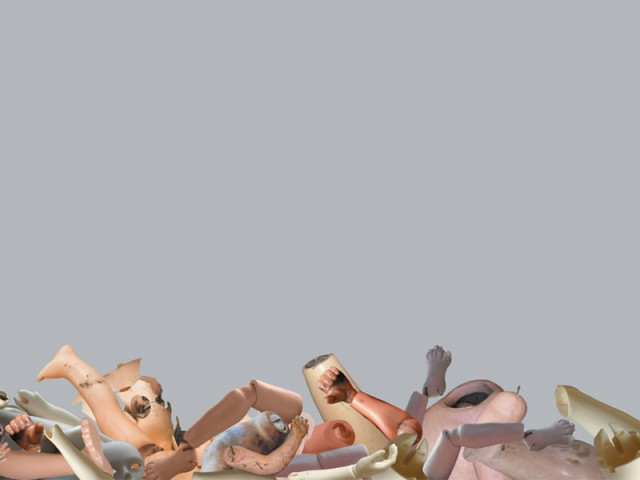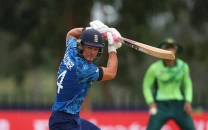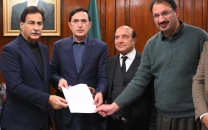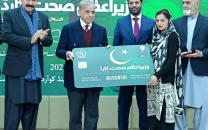What lies beneath
Beneath Karachi’s dazzling lights and bustling commerce is a dark underworld of kidnappings, murder and torture.

What lies beneath
Twenty-seven-year-old Shahnawaz went missing on August 15 and was found dead two days later. His three young children will now grow up without knowing their father’s love.
“He was on his way to Zainab Market to buy frocks for his daughters and jeans for his son for Eid,” says Maula Bux. Recounting the last conversation he had with his son, his eyes mist over. “I had heard that there had been announcements in the area, warning that Baloch boys were vulnerable to kidnappings. I told Shahnawaz to be careful but he was not worried.”
But Maula Bux’s worst fears came true when Shahnawaz’s brutally tortured body was found stuffed in a gunny sack and dumped on a roadside in PECHS, with a suspicious red string around his wrist. His tale is only one of the many horror stories that emerged during the height of the bloodletting this July and August in Karachi.
“Around 46 Baloch men were abducted and killed this August while 12 are still missing,” claims Zafar Baloch, a senior member of the defunct People’s Amn Committee and a former general secretary of the PPP’s south division. “Two of my cousins were also kidnapped and tortured, but fortunately they both survived.”
Baloch’s own relatives were among those 18 missing men whose release was secured after intense negotiations between the police and rival political parties.
Shahnawaz wasn’t as lucky, his fate sealed by a length of red string. “Shahnawaz and others like him had a red string around their wrists. This was a common clue found by the police on those who had been separated from the rest of the kidnapped people and sent to the private torture chambers,” claims Zafar Baloch.
The existence of torture and death cells in many localities of the city is corroborated by the numerous bodies found in gunny sacks, dumped in different areas. The phenomenon of the bori band lash — the consequence of kidnappings for torture and murder — stems from the violent ‘90s, when such tactics were first used.
As for the victims, they are drawn from every major ethnic group in the city but, by and large, they have been people without any real political affiliation, who appear to have been singled out only because of their ethnicity. Most of the people abducted were daily-wage earners. In many cases, victims were dragged from public transport, their identity cards checked and then kidnapped. The W-11 passenger bus recently became a symbol of horror due to frequent abductions. In one case, it was set ablaze by unidentified men with the passengers still inside.
Every community and political party has its own story to tell. The MQM’s Dr Farooq Sattar claims that over a dozen men belonging to the Urdu-speaking community are still missing while some 20 had been recovered after being subjected to brutal torture.
Similar claims are made by Bashir Jan, a senior leader of the ANP Sindh. He relates the spine-chilling account of a Pashtun survivor, who spent eight hours in a gunny sack after being tortured and shot and was dumped on the roadside when his captors mistakenly thought him dead. “At one point, he accidentally stuck his head out of the sack when he was being transported in a rickshaw to be disposed of. His abductor, still thinking he was dead, used his foot to push his head back into the sack,” reveals Jan. “When he reached the hospital after being picked up by an ambulance, only then did he take his hand out of the sack and ask for water. The ambulance driver was shocked.”
This is not the only tale of survival that has emerged from the dark nightmare of Karachi’s violence. Fifty-year-old Ahmed* , a resident of Bilal Colony, which is dominated by the Urdu-speaking community, was abducted at gunpoint from Orangi’s Sector 12 and held captive for three days.
“I was on my way to Sabzi Mandi in a taxi cab when the driver stopped at Bismillah Market near Sohrab Goth. Two Baloch men got in. One of them sat next to me and pointed a gun at me. The whole time he and the other kidnapper were constantly talking on the mobile in Balochi. They took me all the way to Thatta and demanded a ransom of Rs 500,000,” recalls Ahmed. “They told me they were enemies of Urdu-speaking people and wanted to kill all of them. They hit my legs, tied a rope around my neck and hit me with a thick stick due to which I was temporarily paralysed on one side. One of them used to slap me on both my ears simultaneously which would make my whole body go numb with pain.”
Luckily, Ahmed managed to escape when the door of the room he was kept in was left unattended for a little while.
Muhammad*, 26, is another lucky survivor from Baba Vilayat Shah colony in the same neighbourhood: “I was on my way to Yusuf Goth for work when five men on two motorbikes came from behind. Three of them looked Baloch and two seemed as if they were Pashtun. They blindfolded me and one of them sat with me on my bike. They abducted me at around 2 in the afternoon and kept me till 8 pm. They tortured me until they got a call from someone on their mobile. Then they discussed whether I should be kept here or sent to another place to be killed,” says Muhammad. “They beat me with sticks, slapped me repeatedly and told me ‘You are a Mohajir and Mohajirs kill Pathans and Baloch. You torch vehicles and ransack shops. You are a criminal because you are a supporter of Altaf Hussain.’”
According to Muhammad, the sound of a siren from a police mobile distracted his captors and gave him the opportunity to escape. Dreading the worst, his family was surprised at his return. “I guess my time has not come yet,” adds Muhammad.
Gul, a student of Class 9 and an inhabitant of the Pashtun-dominated Muhammadpur area of Orangi Town, was another victim of this politico-ethnic power struggle.
“I was picked up by four men from Qasba Colony near Hina Bakery. Their faces were hidden behind scarves. They tortured me for eight to nine hours, taking turns to beat me. I was bleeding profusely, and I told them to kill me because the pain was too much. Being a Pashtun was my only crime,” recalls Gul.
His desire to stay alive eventually overwhelmed his fear; he snatched a loaded gun from his kidnappers as they were about to execute him. “At first, I was blindfolded and my hands were tied. Later on, they untied my hands, as they were confident that I would not try to escape. They took me to an imambargah along the river and told me to face the wall but I couldn’t because I was in pain. Then they kicked me and loaded the pistol. It was as if I saw my death before my eyes. I thought, these men will kill me – at the very least I should try to escape, may Allah may help me,” says Gul.
His intrepidness in the face of certain death saved him, but hundreds of others were not so lucky.
Ahmed, Muhammad and Gul do not blame any one faction or party, but point to what they can only call ethnic warfare. Behind the brutal violence lies a long-standing and complicated ethnic rivalry among the Pashtun, Urdu-speaking and Baloch communities. This situation has left both political workers, as well as the common man at the mercy of criminal gangs who use the cover of ethnic conflict for their own ends.
These survivors maintain that these destabilising elements are trying to carve Karachi into gangsters’ fiefdoms where only the law of the jungle prevails. They say that loyalty revolving around ethnic affiliation is only limited to the statements and the coloured flags of political parties, while the real issue is that of turf, territory and control. Consuming the lives of countless innocent people, violence and murder are just bargaining chips in Karachi’s power politics.
*Names have been changed to protect identities.
Published in The Express Tribune, Sunday Magazine, October 23rd, 2011.



















COMMENTS
Comments are moderated and generally will be posted if they are on-topic and not abusive.
For more information, please see our Comments FAQ